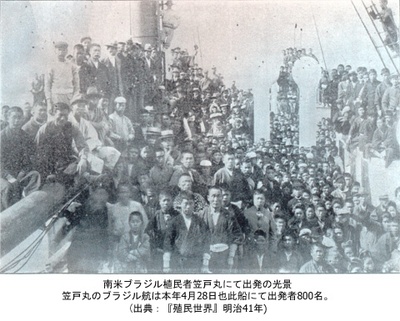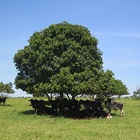100年前の今頃、移民781人の契約移民と自由渡航者たちを乗せた笠戸丸は洋上にあった。サントス港に到着する6月18日まで、神戸港を出てから60日の航海である。
この笠戸丸移民の集合写真、というものがありそうでない。私が知っていたのは、ずっと鹿児島県出身者が神戸の神社で撮影したという一枚の写真だけだった。だけだった、と過去形にできるのは、つい最近、別の一枚を見る機会があったからで、その一枚をここに掲げる。笠戸丸甲板上に勢揃いした移民たち の、おそらく出港前の記念撮影である。
画像というのは不思議なもので、私のように想像力の羽ばたきの弱い人間でも、一見すればどこかが刺激されるらしく、いろんな思いがひっぱり出されて くる。どうやらこの写真、知っている人にはとっくに知られていたものらしいが、ブラジル日本移民史に興味を持ちながら、これまで笠戸丸移民についてはあま り明瞭なイメージを描けないまま来た私にとっては、ひとつの新しい、ちょっとした出会いだ。
はっきり見えるのは前のほうに写っている数名にすぎないが、移民たちの顔、というより面構えと言いたくなるような彼らの表情をどう読み取ればよいのだろ う。不安でもなく、かといって決意といった清々しいものでもない、なんとなくふてぶてしさすら感じるのは、ブラジルでコーヒー農園に入った彼らの多くに、 待遇に怒ってストライキを起こしたり、さっさと見切りをつけて都市や遠くアルゼンチンにまで行って働く主張と行動力があったこと、一方で農園に残った人び との、そんなトラブルにもかかわらず日本移民はダメだと烙印を押させなかった粘り強さを知っているからだろうか。いずれにしろ私の目には、この後大正、昭 和、平成と生きて今日にいたった同じ日本人の表情には見えない。
そもそも今のわれわれには、60日かけてようやく行きつく未知の土地などというものが残されていない。ほとんど情報のない土地へ自分と家族の生活を かけて出発するという選択もまずないだろう。ネットを通じて綿密な情報収集ができる旅行者は、メールを通じて知り合った現地在住者とまるで旧知であるかの ように「再会」し、その土地のネットワークに苦もなく溶け込んでいくのが珍しくもないご時勢だ。
甲板上で撮られたこの写真が出港時のものだとすれば、われわれには想像もできない旅に向け、もう後戻りができなくなった時点ということだ。そんなときに人はいったいどんな表情をするのだろう。私には読み取れなくて当たり前かもしれない。
それにしてもこの写真を見ていると、彼らをブラジルに向かわせたものが何だったのか、もう一度よく
考えてみたいという気持ちにさせられる。
人はなぜ移民となるのか。いちばん一般的で、説得力もある答えは、その時の経済状況からされる説明だろう。近代日本の景気状況と移民送出数を示すグラフを 重ねると、相関関係は明らかだ。人は食うために、家族を食わせるために、生活を豊かにするために海を渡る。実に簡明な説明である。
それだけだろうか、と、しかしもうひとつ胸に落ちない思いがいつもあった。
移民という選択肢以外に生計を成り立たせる方法はほかにもありはしなかったか。あえて家郷を離れ、言葉すら通じない人の間に入り、金のなる木がある という噂(本当に信じたのか?)だけを頼りに保証のない生活に飛び込むほどの賭けに出なければならなかったと簡単に納得はできない。
そんな考えを持って思い入れたっぷりに写真を眺めていると、笠戸丸に乗り込んだ移民たちが、やはり当時としても特別な「冒険心」(もっと適切な言葉 がありそうだが思いつかない)を持った人びとのように見えてくる。それは今でも、個性的な移民一世たちと実際に接する中で時々感じるものでもある。ほんと うの冒険心というのは、だれにでもある資質ではなく、ある種の人にだけ宿るものだというのが私の考えだ。
それは、合理的な思考を鈍らせ、まわりの人びとを巻き込んでありえない進路を選ばせ、おそらくは「失敗」という結果に帰着することが多い。「失敗」 といってももちろんひとつの価値観に基づいての評価にすぎないが。かれらはただ、見たこともないものを見たい、行ったことのない土地に行ってみたい、人が 経験できない生活を経験したい、という思いに憑かれた人たちだったのではないか。この写真から私は不思議なエネルギーを感じるのだが、それはそんな精神を もった人間が一同に会しているところから発するものかと思う。
世界は結局、そういった人びとがいて、得にならない、不合理な選択を時々しながら新しい道を切り拓いてきたからなんとかここまで存続してきたという こともいえる。個人としては損になることが多そうな冒険心を持つ人間がいつまでも淘汰されずにいるのは、その存在が長い目で見れば人類に利益もたらすからだという考え方もあるだろう。笠戸丸移民の係累は、そう考えると人類史上にたくさんいることになる。
笠戸丸移民については、ウソの宣伝にだまされてブラジルに来た被害者という見方もある。その側面を認めない訳ではないが、それ一辺倒の見方はかれらに失礼だと思えてくる。
さて、写真の彼らの視線の先にはカメラがある。その傍らにまさに立っていたかも知れない、彼らをブラジルに導いた張本人である水野龍がいったい何を考えてこのような企てをしたのか、これも再考に価するテーマだ。
© 2008 Shigeo Nakamura





